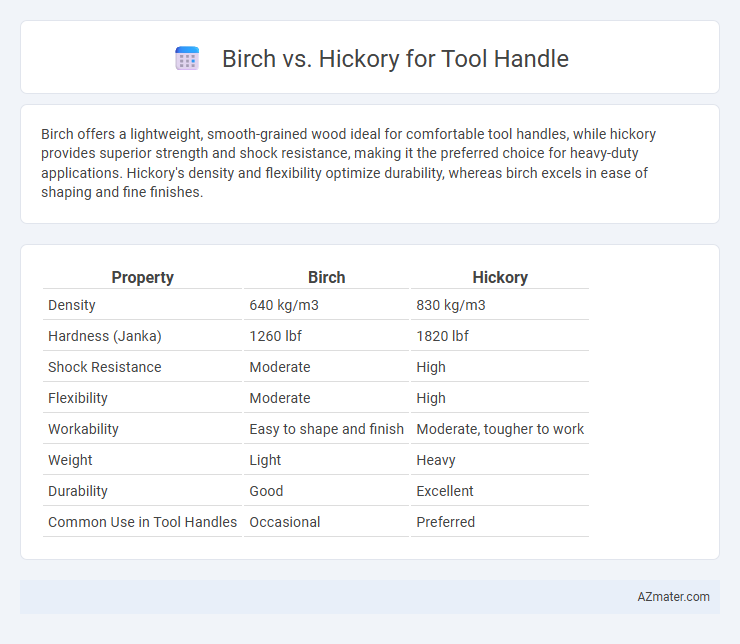Birch offers a lightweight, smooth-grained wood ideal for comfortable tool handles, while hickory provides superior strength and shock resistance, making it the preferred choice for heavy-duty applications. Hickory's density and flexibility optimize durability, whereas birch excels in ease of shaping and fine finishes.
Table of Comparison
| Property | Birch | Hickory |
|---|---|---|
| Density | 640 kg/m3 | 830 kg/m3 |
| Hardness (Janka) | 1260 lbf | 1820 lbf |
| Shock Resistance | Moderate | High |
| Flexibility | Moderate | High |
| Workability | Easy to shape and finish | Moderate, tougher to work |
| Weight | Light | Heavy |
| Durability | Good | Excellent |
| Common Use in Tool Handles | Occasional | Preferred |
Introduction to Birch and Hickory Tool Handles
Birch tool handles are valued for their smooth texture and flexibility, making them ideal for tasks requiring precision and control. Hickory tool handles are renowned for their exceptional strength, shock resistance, and durability, commonly favored in heavy-duty applications like axes and hammers. Both woods offer unique advantages in ergonomics and performance depending on the specific tool use and user preference.
Physical Properties Comparison: Birch vs Hickory
Birch wood features a fine, even grain with moderate hardness and good shock resistance, making it suitable for tool handles that require a balance of strength and flexibility. Hickory, known for its exceptional toughness and high density, exhibits superior impact resistance and durability, ideal for heavy-duty tool applications. While birch offers lighter weight and ease of shaping, hickory provides enhanced resilience and longevity under repeated stress.
Strength and Durability Differences
Hickory exhibits superior strength and durability compared to birch, making it the preferred choice for tool handles subjected to heavy impact and stress. The dense grain structure of hickory provides excellent shock absorption and resistance to wear, extending the lifespan of tools. Birch, while still strong, is generally softer and less resilient, better suited for lighter-duty handles where flexibility is less critical.
Shock Absorption and Flexibility
Birch offers moderate shock absorption with a relatively stiff structure, making it durable but less flexible for tool handles. Hickory excels in shock absorption due to its excellent toughness and natural grain patterns, providing superior vibration dampening and flexibility. These properties make hickory the preferred choice for tool handles requiring enhanced durability and comfort during repetitive use.
Weight and Balance in Tool Handles
Birch tool handles offer a lighter weight compared to hickory, enhancing maneuverability during prolonged use. Hickory provides superior balance and shock absorption, making it ideal for heavy-duty tools requiring durability and control. The choice between birch and hickory handles depends on the need for lightweight precision or robust impact resistance.
Workability and Ease of Shaping
Birch wood offers excellent workability and ease of shaping due to its fine, uniform texture and moderate hardness, making it ideal for intricately carved tool handles. Hickory, known for its exceptional toughness and shock resistance, is denser and more challenging to shape but provides superior durability under heavy use. Both woods balance strength and workability, though birch is preferred for detailed shaping while hickory excels in demanding tool applications requiring long-lasting handles.
Resistance to Moisture and Environmental Factors
Birch tool handles offer moderate resistance to moisture, making them suitable for indoor use but more prone to swelling or warping in high humidity. Hickory excels in resistance to environmental factors, including moisture, due to its dense grain structure and natural oils, providing superior durability in outdoor or variable conditions. Tools with hickory handles maintain structural integrity and grip better, resulting in longer lifespan and enhanced safety in harsh environments.
Cost and Availability of Birch and Hickory
Birch tool handles offer a budget-friendly option with moderate durability, making them widely available and cost-effective for general use. Hickory handles, though typically more expensive, provide superior strength and shock absorption, justifying their higher price in heavy-duty applications. Availability of hickory can be more limited depending on the region, whereas birch is more commonly stocked and easier to source in most hardware stores.
Common Uses for Each Wood Type in Tool Handles
Birch is highly valued for tool handles requiring resilience and smooth finishes, commonly used in hammers, axes, and chisels due to its fine grain and shock resistance. Hickory, known for superior strength and impact absorption, is preferred for heavy-duty tool handles like mauls, sledgehammers, and baseball bats, providing durability under intense stress. Both woods are favored for ergonomic grips, but hickory excels in applications demanding maximum toughness and wear resistance.
Conclusion: Choosing the Right Wood for Your Tool Handle
Birch offers a lightweight and smooth finish ideal for precision tool handles, while hickory provides superior strength and shock resistance suited for heavy-duty use. The choice depends on the tool's purpose, with birch favoring comfort and control, and hickory ensuring durability and impact absorption. For long-lasting, high-impact applications, hickory is the preferred option, whereas birch suits fine woodworking and lighter tasks.

Infographic: Birch vs Hickory for Tool Handle
 azmater.com
azmater.com